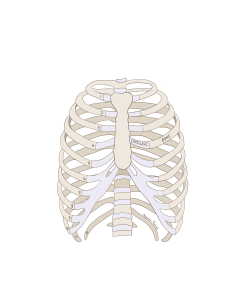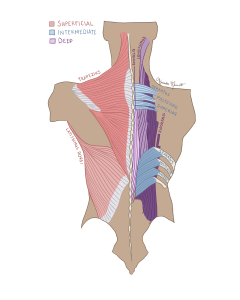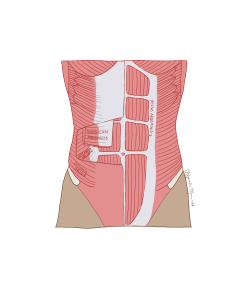36 Trunk and Abdominal musculature
Trunk Musculature:
Before diving into the muscles of the trunk, let’s clear up an important distinction: the trunk is not just the “core.” While the core is a major component, the trunk includes all the muscles that help stabilize, support, and move the torso. These muscles contribute to posture, breathing, and movement of both the spine and limbs. To better understand these functions, let’s discuss gardening! Whether you’re planting flowers, pulling weeds, or lifting a watering can, the muscles of your trunk are actively engaged in keeping you balanced and anchored. Without them, even simple tasks like bending to pick up a potted plant or twisting to grab a tool would feel uncoordinated and strenuous.
Bones of the Trunk:
The trunk’s structural integrity comes from the vertebral column, rib cage, and sternum. The spine is composed of 33 vertebrae that provide support, flexibility, and protection for the spinal cord. The rib cage consists of 12 pairs of ribs that encase vital organs, while the sternum (breastbone) provides an anchor point for the ribs. These bones serve as attachment sites for muscles that enable movement and stability. Every time you take a deep breath or adjust your posture, the interaction between these bones and muscles ensures smooth and controlled motion.

Figure 79 Anterior view of the bones of the rib cage
Posterior Trunk Muscles
The posterior trunk muscles, often called “back muscles,” play a key role in maintaining posture and generating movement in the spine and shoulders. They can be divided into superficial, intermediate, and deep layers.

Figure 80 Muscular layers of the posterior trunk
- Superficial Layer: These are the muscles you might feel stretched after a long day of bending over in the garden. The latissimus dorsi, for example, assists in pulling motions of the shoulder, such as tugging a stubborn weed out of the ground. This broad muscle spans the lower back and inserts into the upper arm, making it essential for forceful, pulling movements. The trapezius, a large triangular muscle in the upper back, helps elevate and retract the shoulder blades, useful for when you’re reaching up to touch a tree branch or when shrugging your shoulders after an exhausting day of yard work.
- Intermediate Layer: These muscles assist with respiration and include the serratus posterior superior and serratus posterior inferior, which help lift and depress the ribs, respectively, during breathing. When you take a deep breath to smell the great smell of the lavender you just planted, these muscles engage to support rib movement, making it easier to expand your lungs. While they don’t play a primary role in breathing, they contribute to overall respiratory efficiency.
- Deep Layer (Intrinsic Back Muscles): These muscles are responsible for spinal movement and posture, keeping your back straight. Also known as the erector spinae, these muscles run along the spine and help you straighten your back after bending down to dig a hole for a new plant. Composed of three muscle columns (iliocostalis, longissimus, and spinalis) this group allows controlled extension of the spine, which is crucial when transitioning from a crouched to a standing position. The transversospinalis group contributes to spinal rotation and stabilization, engaging when you twist your torso to grab a bag of soil from behind you. These deeper muscles work together to keep your movements smooth and coordinated, preventing unnecessary strain on your back.
Anterior Trunk Muscles:
On the front side of the trunk, the anterior muscles contribute to spinal flexion, lateral bending, and rotation. These muscles help stabilize the torso during dynamic movements, ensuring balance and control during activities requiring forward bending or side-to-side motion.

Figure 81 Muscular layers of the anterior trunk
- Rectus Abdominis: Often referred to as the “six-pack” muscle, the rectus abdominis is crucial for spinal flexion. Imagine leaning forward to plant seeds in the soil. You are engaging this muscle to bring your torso down toward your legs in a controlled manner! This long, strap-like muscle runs vertically along the abdomen and is segmented by tendinous intersections. It not only aids in forward bending but also contributes to stabilizing your core when lifting those heavy gardening tools.
- Obliques (Internal & External): These muscles assist in twisting and lateral flexion. If you’re rotating to grab a garden tool or bending sideways to reach a planter, your obliques are engaged to make it happen. The external obliques, positioned on the outermost layer, work with the deeper internal obliques to generate rotational force.
- Transversus Abdominis: This deep muscle acts like a corset, wrapping around the torso to provide stability. It plays a crucial role in core bracing (think of it as the tension you feel when lifting a heavy bag of compost while keeping your spine protected). Unlike the rectus abdominis and obliques, which mainly generate movement, the transversus abdominis primarily serves as a stabilizer. Engaging this muscle is key to preventing lower back strain, especially when carrying heavy gardening tools or maintaining balance on uneven terrain.
Breathing and the Role of the Diaphragm:
Breathing is a fundamental function influenced by trunk musculature. The diaphragm, a dome-shaped muscle located beneath the lungs, contracts and flattens as you inhale, creating space for air to enter. When you exhale, it relaxes, pushing air out. The diaphragm is a primary respiratory muscle that is no doubt a necessity in breathing, yet during strenuous activities we may require additional muscles to increase air flow, these are known as secondary respiratory muscles. These secondary respiratory muscles like the sternocleidomastoids and scalenes of the neck aid in elevation of the rib cage so we can breathe in more air before bracing to pick up a heavy bag of soil. Other secondary respiratory muscles like the latissimus dorsi and the abdominal muscles aid in forced expiration so we can expel excess air after dropping that bag of soil off at the edge of your garden. The latissimus dorsi is especially important during activities that require sustained effort, like shoveling dirt or watering plants with a heavy can. Coupled with proper breathing mechanics, these trunk muscles can further help distribute oxygen efficiently, allowing you to work longer without fatigue.
Functional Movements and Everyday Applications:
Overall, we can summarize that the trunk muscles work together to support movement and stability of the back and trunk. Now let’s put this all together within the context of our gardening example:
- Lifting and carrying: Picking up a bag of fertilizer from the ground requires a coordinated effort between the erector spinae, rectus abdominis, and transversus abdominis to stabilize the spine and generate force. Engaging these muscles properly prevents undue stress on the lower back and reduces the risk of injury.
- Twisting and rotating: Turning your torso to look over your shoulder when pushing a wheelbarrow full of soil engages the obliques and deep spinal stabilizers. Controlled rotation prevents excessive torque on the spine, ensuring smooth and efficient movement.
- Postural control: Sitting for long periods while maintaining an upright posture (such as reading this chapter!) relies on continuous engagement of both anterior and posterior trunk muscles. Without them, slouching and discomfort would set in quickly, affecting overall spinal health.
Finally, after a long day’s work, you take a deep breath, letting your body relax. Your diaphragm contracts, drawing in fresh oxygen to help you recover, preparing you for another day in the garden.
The muscles of the trunk serve as the foundation for nearly every movement we make. Whether you’re gardening, lifting groceries, or simply standing upright, these muscles provide the stability and strength necessary for everyday life. By understanding their function and engaging them properly, you can improve posture, prevent injury, and enhance overall movement efficiency. Now that you have a solid grasp of the trunk’s musculature, let’s move on to how these muscles interact with the lower limbs in supporting mobility and balance.

